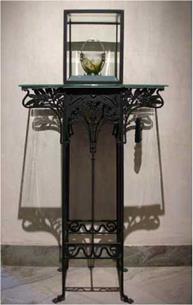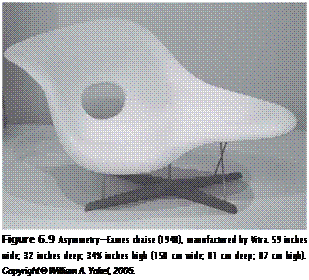Design principles provide criteria that describe formal intentions. The intended purpose of a chair or table can begin with a range of needs or desires and develop through any number of processes. Along the way, furniture designers are confronted by design principles, which require the eye and the hand to work together in a complex system of thought and action. The principles of design covered in this chapter are:
■ Balance: Structural and Visual, Symmetry and Asymmetry
■ Continuity, Unity, and Variety
■ Dynamism and Stasis
■ Hierarchy and Emphasis
■ Juxtaposition
■ Rhythm and Pattern
■ Scale and Proportion
Balance: Structural and Visual, Symmetry and Asymmetry
Visual balance is the spatial weighing of a composition around an axis. Structural balance involves the physical equilibrium of freestanding elements such as chairs and tables. Furniture must be able to withstand lateral, shear, live, and moment forces. Visual balance and structural balance are related but distinct concepts.
|
|
||
Structural Balance
Structural balance considers the forces in furniture to be in equilibrium. When forces are not in equilibrium, cantilevers can fail, shelves can sag, and furniture can tip over. Furniture must be able to withstand lateral forces (forces applied from the side), shear forces (internal forces working in parallel but opposite directions), and moment forces (rotational forces applied to joints).
Structural forces inspire design ideas and are an important consideration in the conception of form. Frank O. Gehry’s bentwood chairs resulted from a structural and material investigation using 3/32-inch (2.4-mm) thick maple veneers assembled and composed in various ways (Figure 6.6).
 Rocking chairs give the user control of back-and-forth movement and rely on the weight and motion of the user, the form of the chair, and the center of gravity of both the user and the chair to function properly. Rocking back and forth creates significant dynamic forces, stressing both the form and joinery of the rocker. The goal of the classic bentwood rocker by Michael Thonet (Figure 6.7) is to obtain a fluid and balanced rocking motion through a symbiotic relationship between the rocker and the user.
Rocking chairs give the user control of back-and-forth movement and rely on the weight and motion of the user, the form of the chair, and the center of gravity of both the user and the chair to function properly. Rocking back and forth creates significant dynamic forces, stressing both the form and joinery of the rocker. The goal of the classic bentwood rocker by Michael Thonet (Figure 6.7) is to obtain a fluid and balanced rocking motion through a symbiotic relationship between the rocker and the user.
In cases where furniture is precariously tall and narrow or where the center of gravity lies beyond the tipping point, it may become necessary to attach furniture to a floor, wall, or ceiling in order to maintain structural stability. There are dimensional limits to the horizontal span of shelving before deflection occurs and imbalance appears. Shelving systems, bed frames, music stands, grandfather clocks, cabinet doors, and speaking podiums all depend on basic engineering principles to maintain structural balance and function safely.
When a person is sitting in a chair, the tilting point should be located directly beneath the center point of gravity for the chair and body combined. The principle of balance is an important aspect to consider and achieve in the design for any human body support.
Visual Balance
The spatial weighing of visual balance expresses either symmetrical or asymmetrical composition. Symmetry is a form of balance where a component (or several Figure 6.8 Bilateral symmetry—Art Nouveau components) is mirrored along an axis. The Art Nouveau selette shown in Figure
sellette. Photography by Jim Postell, 2006. 6.8 is bilaterally symmetrical, which places emphasis on its vertical axis and,
consequently, on the object displayed on top of the selette.
 Symmetry can be expressed bilaterally (around a common axis) or radially (around a common point).
Symmetry can be expressed bilaterally (around a common axis) or radially (around a common point).
Visual balance does not rely entirely on symmetry. Much of the abstract cubist furniture from the 1930s and the de Stijl – style furnishings by Gerrit Rietveld and Theo Van Doesburg express balance but are not symmetrical. Asymmetrical balance is dynamic and appears in equilibrium along an axis through its form, though it cannot be mirrored. Gerrit Rietveld’s Berlin chair (1923) and Charles and Ray Eames’s fiberglass-reinforced plastic Eames chaise (1948) are visually balanced, asymmetrical compositions (Figure 6.9).





